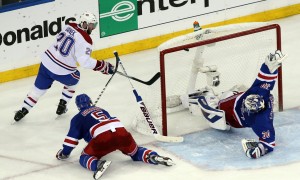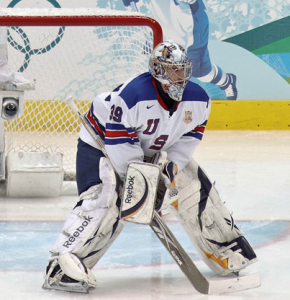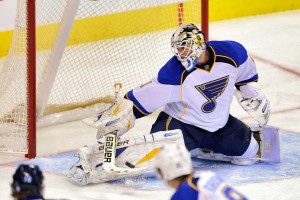
Henrik Lundqvist has earned the money Ryan Miller demands
From NHL, international, Olympic and even inline hockey success with Team Sweden in 2002, Henrik Lundqvist has one more hurdle to surmount — and he’s four wins from doing just that. Widely considered the best goalie in the world over the past few NHL seasons, Lundqvist was finally rewarded with his first Vezina Trophy in 2012. Lundqvist also has numerous ancillary achievements such as leading the New York Rangers in most statistical categories, and is the only goalie in NHL history to notch at least 30 wins in each of his first seven seasons. As a result of the voluminous achievements he’s attained in during his professional career, Lundqvist is also one of the highest-paid goalies in the NHL, with an $6.8 million AAV cap hit. Now, he’s also an Eastern Conference champion, leading a team no one picked to contend for much this season to within a breath of a Stanley Cup on the 20th anniversary of their 1994 title.

Ryan Miller seeks to use Lunqdvist’s current contract as the benchmark for his own
Ryan Miller like Lundqvist has been part of the Vezina conversation for the past few seasons. He also has one of the biggest goalie contracts in the league at $6.2m AAV. Without question, Miller’s 2010 Olympic MVP performance and Vezina trophy playing for one of the league’s worst teams are solid achievements. However, while Miller hasn’t played on contending teams over the past few years, that hasn’t always been the case, with Buffalo considered at least able to get past the first couple rounds. In addition, it should be noted that even in the Sabres’ President’s Trophy campaign of 2006-2007, they finished middle-of-the-pack in goals against. Although Lundqvist has also played on top regular season squads, unlike Miller he rather than the offense was carrying the team. Only Lundqvist has been able to get his team past the first two rounds after playing many for the same franchise while also putting up stellar individual numbers.
Ryan Miller was brought in to do much of the same thing for the St. Louis Blues that Lundqvist is doing for his team. And, although it’s been proven over and over that that’s poor future planning, that’s also the type of thing that today’s goaltender must do in order to be even considered for big money. He must prove without a shadow of a doubt he’s the best player on the team — a figure without whom the franchise’s chances would be crippled. In the case of the Sabres, he was, but it was also irrelevant because the team was going nowhere. On most Stanley Cup favorites, the goalie ironically is usually not the best player — or at least doesn’t need to be. The Rangers were not part of that conversation prior to this year, but Lundqvist along with the addition of Martin St. Louis has made them so. The salary trend for goalies is moving the opposite direction — largely spurred on by the results of the 2010 Final — that saw upstart Antti Niemi defeat journeyman Michael Leighton for the title. Since then, many teams realized that it is indeed possible to lift the chalice without spending tons on goaltending. In fact, the Blackhawks did it again in 2013 with many of the key 2010 players gone due to salary cap constraints, this time using Corey Crawford. Although Crawford was rewarded with a solid contract after that victory, he never would have on the strength of anything else he’s done as a player. The Blackhawks are the prototypical example of a team that could replace their current goalie with another and probably achieve similar results, given their current core and team spending philosophy.

St. Louis is slowly learning its lesson
By largely remaining status-quo with the rest of the team and investing numerous assets in a goalie at the 2013-2014 trade deadline, the St. Louis Blues ignored the modern trend of focusing on the rest of the roster while icing a competent — although not necessarily superstar — goalie. By sacrificing reliable if injury-prone goalie Jaroslav Halak, forward Chris Stewart and promising prospect William Carrier along with a couple picks, Blues GM Doug Armstrong told the team and the city that the only thing preventing it from advancing deep into the playoffs was the competency of their starting goaltending. After an inauspicious exit in the first round, this was proven to not be the case. Although there is valid debate on both sides regard the expendability of those assets in order to acquire Miller, one wonders who could have been had at the forward position for a similar package. Doug Armstrong to his credit has acknowledged the foolishness of dumping large money on Miller when the Blues are a team clearly in need of timely scoring rather than keeping the puck out of their own net, a focus that is widely suspected to be their primary goal this off-season. The Blues plan on rolling with proven goalie Brian Elliott and AHL star Jake Allen, a move diametrically opposite to investing north of $6m in one goalie as they might have with Ryan Miller.
In essence, Henrik Lundqvist is showing to the rest of the league the circumstances under which a team heavily invests in goaltending. He must carry the team at times, in addition to having a resume and reputation that gets into opposing teams’ heads prior to ever hitting the ice. This may prove problematic for a guy like Miller, hoping primarily to earn reparations for suffering with the Sabres. Two teams with solid and relatively inexpensive tandems — the Anaheim Ducks and San Jose Sharks — have already said they aren’t really interested in his services. These are also unsurprisingly two teams that could fix a couple holes and win with those cheaper goalies — especially if the Ducks jettison Jonas Hiller. If the Blues follow through with their plan to go with competent and inexpensive goaltending and properly invest in the scoring punch they so desperately require, they might finally be on the same page as those teams that understand success in today’s league is not necessarily built from the goal out.